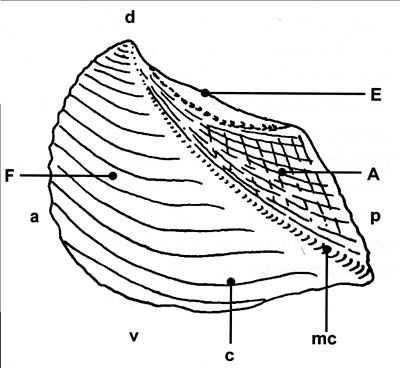Trigonia
| Trigonia | |
|---|---|
| | |
| A fossil shell of Trigonia interlaevigata from Germany, of Jurassic age | |
| Scientific classification | |
| Kingdom: | Animalia |
| Phylum: | Mollusca |
| Class: | Bivalve |
| Order: | Trigoniida |
| Superfamily: | Trigonioidea |
| Family: | Trigoniidae |
| Subfamily: | Trigoniinae |
| Genus: | Trigonia Bruguiere 1789 |
Trigonia is an extinct genus of saltwater clams, fossil marine bivalve mollusk in the family Trigoniidae.

Diagram of Trigonia costata James Parkinson, showing main morphological features of the shell exterior; a) Anterior; p) Posterior; d) Dorsal; v) Ventral; F) Flank; A) Area; c) Costae; mc) Marginal Carina. Trigonia costata ranges from the Lower Jurassic (Toarcian) to Middle Jurassic (Callovian).
Description
The genus Trigonia is the most readily identifiable member of the familyTrigoniidae, having a series of strong ribs or costae along the anterior part of the shell exterior. They are the first representatives of the family to appear in the Middle Triassic (Anisian) of Chile and New Zealand. The first European examples (Trigonia costata Parkinson) turn up in the Lower Jurassic (Toarcian) of Sherborne, Dorset and Gundershofen, Switzerland.[1]
References
- ↑ Francis, A.O. 2000. The Palaeobiology of the European Jurassic Trigoniidae. Ph.D. thesis, University of Birmingham, 323pp.